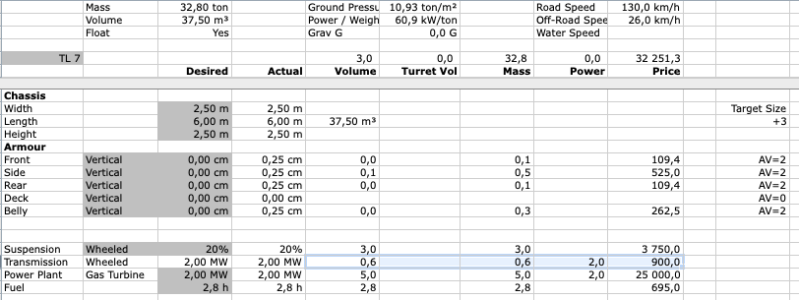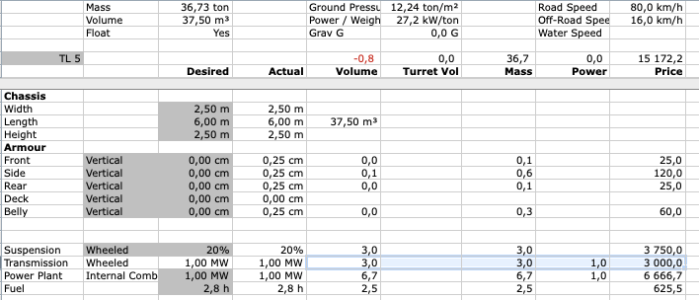CT Errata (DonM):
Page 26, Wheels, Suspension (correction): Wheels require at least 1.5% of chassis volume.
Page 26, Tracks, Suspension (correction): Tracks require at least 2.0% of chassis volume.
Yes, "at least", but you might want to use more to reduce ground pressure, in order to improve terrain capability, see Striker.
Note that suspension volume does not affect transmission volume.
However, I freely admit that I have no idea what this Errata means:
Page 27, Locomotion: Transmissions (Legs, Tracks, Wheels) (omission): Note the power requirements: each leg, 40kW; track, 30kW, wheels, 20kW. Each unit is per kW of power plant output.
[It appears to state that for each 1 kW of PP, my wheels need 20 kW of PP ... high on the list of things that make you go "SAY WHAT???" I think it meant to be the other way around ... 20 kW of power to the WHEELS for each MW of power plant output = 0.02 kW of power to the WHEELS for each kW of power plant output. However, who knows for sure what was intended.]
Recheck the version of the errata. I get:
Consolidated CT Errata 1.2 (03/31/15), p21:
_ Page 27, Locomotion: Transmissions (Legs, Tracks, Wheels) (omission): Note the power requirements: each leg, 0.4kW; track, 0.3kW, wheels, 0.2kW. Each unit is per 100kg of robot mass.
Instead of per kW of power plant output, it's now per 100 kg of mass.
So, for a two-legged robot with a chassis volume of 50 l and an estimated mass of 100 kg we get:
Suspension: Two legs à 5% is 10% of volume, so 5 l (external), 5 kg.
Transmission: At 100 kg, one unit of transmission is required (regardless of the number of legs?), using 2×0.4 kW = 0.8 kW, 0.5 l, and 1 kg.
Power: For a 30 h duty cycle, it would require 0.8 kW × 30 h = 24 kWh = 24 l, 24 kg battery at TL-12.
So, just for locomotion we would use 5 kg (suspension) + 1 kg (transmission) + 24 kg (power) = 30 kg for a 100 kg robot.
Note that the transmission gives the power requirement for the locomotion, so is necessary to calculate.
The change to units of transmission based on mass is more "realistic", but more complicated as we basically calculate in volume, but with a feedback loop in mass. For every change in mass, the power plant needs to be recalculated...


